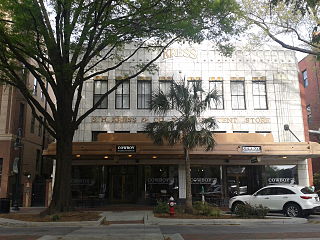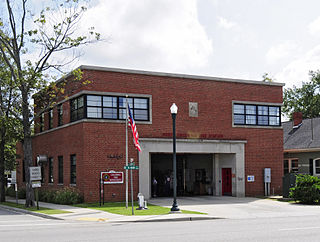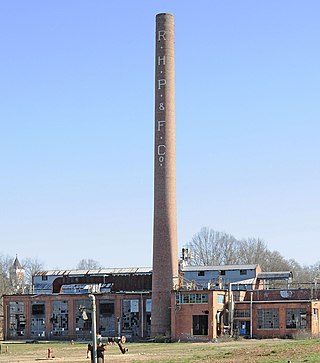
The Clover Hill Tavern with its guest house and slave quarters are structures within the Appomattox Court House National Historical Park. They were registered in the National Park Service's database of Official Structures on October 15, 1966.

Eau Claire Town Hall and Survey Publishing Company Building is a building that was built for the Survey Publishing Company. Later it was the Eau Claire Town Hall. In 1979, it was named to the National Register of Historic Places in 1979.

Olympia Armory is a historic National Guard armory located at Olympia, near Columbia, Richland County, South Carolina.

Horry-Guignard House is a historic home located at Columbia, South Carolina. It was built before 1813, and is a two-story, late Federal style, modified I-house type frame dwelling. The front facade features a one-story, full-width balustraded porch supported by square columns. During the winter of 1813–1814, the main hall was widened from six feet to eleven feet. To do this, the house was sawed in half and the two ends were pulled apart to rest on two new foundations. It was probably built by Peter Horry (1747-1815), a Revolutionary War Colonel and Brigadier General of the South Carolina Militia. Later, the house was acquired by John Gabriel Guignard (1751-1822), the Surveyor General of South Carolina from 1798 to 1802. Guignard is responsible for the early design of the city and laid out the first streets of Columbia.

Raymond Price House is a historic home located at Columbia, South Carolina. It was built in 1952, and is a two-story, "L"-shaped, steel-framed, masonry dwelling in the Streamline Moderne / International style. It has a flat roof and front a rear balconies. Also on the property is a one-story structure that is now an office.

Town Theatre is a historic community theatre located at Columbia, South Carolina. It was built in 1924, and is a rectangular brick building with a two-story glazed central arch with Art Deco influences. A brick annex was added to the rear of the building in the 1950s. It houses one of the first community theatres in the United States.

Building at 1210–1214 Main Street, also known as Capitol Café, is a historic commercial building located at Columbia, South Carolina. It was built by 1871, and is a two-story, seven bay, stuccoed brick building. A cast-iron railing extends across central three bays of the second floor. The Capitol Café was previously located in the building since 1913.

Lever Building is a historic commercial building located at Columbia, South Carolina. It was built in 1903, and is a three-story building faced with brown brick and terra cotta.

Kress Building is a historic commercial building located at Columbia, South Carolina across the street from the Columbia Museum of Art. It was built in 1934 by S. H. Kress & Co., and is a two-story, Art Deco style building faced with white terra cotta and colored terra cotta ornamentation. It features rounded storefront windows and cornice that contains the word "Kress" and surmounted by a stepped parapet.

First National Bank, also known as the National Loan and Exchange Bank Addition, is a historic bank building located at Columbia, South Carolina. It was built about 1924, and is a two-story, stone faced Neoclassical style building consisting of a two-story central section with flanking one-story wings. The front façade features four monumental 3/4 detached Doric order columns.

Richland Cotton Mill, also known as Pacific Mills, Lowenstein Mill, and Whaley's Mill, is a historic cotton mill building located at Columbia, South Carolina. It was built in 1894, and is a four-story, rectangular brick mill building. It features a seven-story stair tower, with a circular vent flanked by two arched vents. Attached to the building are an engine room, a boiler room with chimney, and a machine shop.

Olympia Mill, also known as Pacific Mill, is a historic textile mill complex located at Columbia, South Carolina. It was built in 1899, and consists of a four-story, red brick, rectangular shaped, main mill building connected to a one and two-story red brick power plant. The main building is in the Romanesque Revival style and features terra cotta detailing, large segmental arched window openings, and twin pyramidal roofed towers. The complex also includes: a one-story brick power plant auxiliary building, a one-story storage building, and two small brick one-story gatehouses.

Wardlaw Junior High School, also known as Wardlaw Middle School, is a historic Middle school located at Columbia, South Carolina. It was built in 1926–1927, and is a three-story, rectangular brick structure with a central courtyard. It features Gothic window tracery, arched entrances with one-story porches, and decorative cast stone panels. It was the first junior high school building in South Carolina.

North Columbia Fire Station No. 7 is a historic fire station located at Columbia, South Carolina. It was built in 1948, and is a two-story, brick, transitional Art Moderne / International style building. It features metal window frames, flat roof, and corner ribbon windows.

Harden Street Substation, also known as Harden Street Fire Station, is a historic fire station located at Columbia, South Carolina. It was built in 1953, and is a two-story, rectangular brick building with a flat roof constructed in the Moderne style. It was built by the city of Columbia to house African-American firemen under white officers and maintain institutional segregation.

Good Samaritan-Waverly Hospital, also known as “Good Sam” Hospital and Waverly Hospital, is a historic hospital for African-American patients located in Columbia, South Carolina. It was built in 1952, and is a two-story, brick building in the Moderne style. The hospital housed a pharmacy, laboratory, X-ray room, staff dining room, two operating rooms, and 50 beds to service the local community. The hospital closed in August 1973.

William Jennings Bryan Dorn Veterans Affairs Medical Center is a historic hospital complex and national historic district located at Columbia, South Carolina. The district encompasses 19 contributing buildings and a covered walk. Most of the oldest buildings are two- to three-story brick structures and feature a Georgian Colonial Revival architectural style. The original buildings date to 1932, with additional buildings completed in 1937, 1945, and 1946. A major expansion occurred in the 1970s. In 1978, President Jimmy Carter named the hospital after U.S. Representative from South Carolina, William Jennings Bryan Dorn. The complex includes the hospital, recreation, dining, and residential buildings. The complex is operated by the Veterans Health Administration.

Columbia Central Fire Station, also known as Columbia Fire Department Headquarters and Senate Street Station, is a historic fire station located at Columbia, South Carolina. It was built between 1949 and 1951, and consists of two buildings and a structure. The main building is a two-story, rectangular, brick building in the Moderne / International Style. It has a flat roof and features horizontal bands of windows. The one-story, brick fire truck garage building and the main building were constructed in 1949–1950. The drill tower is a six-story reinforced concrete structure built in 1951. The complex served as the Columbia Fire Department's Headquarters from 1950 until 1995.

Fort Mill Downtown Historic District is a national historic district located at Fort Mill, York County, South Carolina. It encompasses 16 contributing buildings, 1 contributing site, 1 contributing structure, and 4 contributing objects in the central business district of Fort Mill. The buildings are predominantly one and two-story masonry commercial buildings constructed between 1860 and 1940. The district includes the Confederate Park and its Bandstand. Notable contributing resources include the Confederate Soldiers Monument, Catawba Indians Monument, Faithful Slaves Monument, Jones Drug Store, and First National Bank / Old City Hall.

Bleachery Water Treatment Plant is a historic water treatment plant located at Rock Hill, South Carolina. It was built in 1930, and is a one-story brick building and filtration/purification facility in the Colonial Revival style. The city of Rock Hill passed a bond issue to build Bleachery Water Treatment Plant, to support the Rock Hill Printing and Finishing Company investment by M. Lowenstein Company of New York.
























